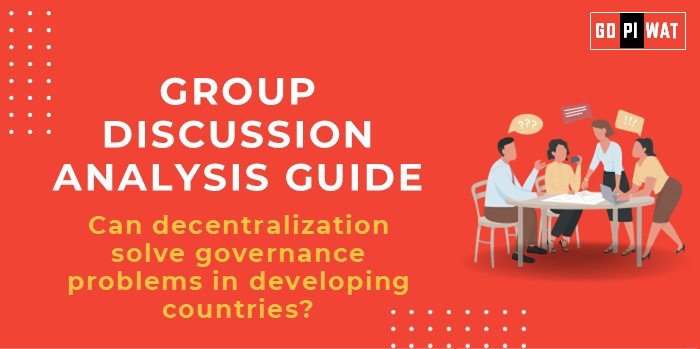📋 Group Discussion (GD) Analysis Guide
🌐 Topic: Can Decentralization Solve Governance Problems in Developing Countries?
🌟 Introduction
- Context: Decentralization is increasingly promoted as a governance strategy to address administrative inefficiencies, enhance local development, and empower communities in developing nations.
- Background: Originating from global movements advocating subsidiarity and local autonomy, decentralization involves transferring decision-making powers from central governments to local authorities. Notable successes in countries like Kenya, Brazil, and India make it a compelling governance model.
📊 Quick Facts and Key Statistics
- Kenya’s Devolution (2013): County governments now control 15% of national revenue, leading to improved healthcare, education, and infrastructure services.
- India’s Panchayati Raj System: Over 2.5 lakh gram panchayats are responsible for implementing rural development initiatives and ensuring grassroots governance.
- Brazil’s Participatory Budgeting: Introduced in 250 municipalities, this initiative has significantly enhanced transparency and fostered active citizen participation in financial planning.
- UNDP Report: Tailored, localized governance solutions are essential for addressing specific deficits and barriers, as generic central strategies often fail to meet diverse community needs effectively.
👥 Stakeholders and Their Roles
- Governments: Draft decentralization policies and allocate resources.
- Local Bodies: Implement policies tailored to local needs.
- Civil Society: Act as watchdogs, ensuring accountability and equitable development.
- International Organizations: Provide funding and technical support for decentralization initiatives.
🏆 Achievements and Challenges
✨ Achievements:
- Improved Public Services: Kenya’s devolution enhanced local healthcare systems and education access.
- Citizen Empowerment: India’s Panchayati Raj system ensures participation, with 33% seats reserved for women, amplifying gender inclusion.
- Transparency: Brazil’s participatory budgeting reduced corruption, increased trust, and boosted community-driven projects.
⚠️ Challenges:
- Resource Inequity: Regions with limited economic activity struggle to generate sufficient local revenue.
- Capacity Gaps: Local governments often lack the administrative expertise or technical infrastructure for effective governance.
- Political Interference: Centralized control tendencies can undermine local autonomy and decision-making.
🌍 Global Comparisons
- Estonia: Leveraged digital platforms to enable decentralized e-governance, ensuring efficiency and reducing bureaucracy.
- South Africa: Despite robust decentralization laws, issues like corruption and lack of capacity hinder effective governance at the local level.
Case Studies:
- India: Kerala’s decentralized healthcare model proved effective during COVID-19, providing prompt local-level interventions.
- Philippines: Barangay-level governance expedited disaster responses, saving lives during natural calamities.
📌 Structured Arguments for Discussion
- Supporting Stance: “Decentralization ensures governance reaches the grassroots, enhancing inclusivity and responsiveness.”
- Opposing Stance: “Without adequate capacity, decentralization risks inefficiency and corruption at the local level.”
- Balanced Perspective: “While decentralization offers benefits, its success depends on resources, capacity, and accountability mechanisms.”
🗣️ Effective Discussion Approaches
- Opening Approaches:
- Highlight a success story, such as Kenya’s healthcare improvements due to devolved governance.
- Contrast centralized inefficiencies with decentralized successes, e.g., Kerala’s COVID-19 response.
- Counter-Argument Handling:
- Acknowledge concerns like resource disparities and propose strategies such as public-private partnerships to bridge funding gaps.
- Use global examples to refute inefficiency claims, citing Estonia’s streamlined e-governance.
📊 Strategic Analysis of Strengths and Weaknesses
- Strengths: Enhances accountability, fosters innovation, and promotes citizen participation.
- Weaknesses: Risk of resource disparity and uneven implementation.
- Opportunities: Digital tools and international collaborations can strengthen local governance.
- Threats: Political interference and lack of robust oversight mechanisms.
📚 Connecting with B-School Applications
- Real-World Applications: Use cases for developing frameworks in rural development, public administration, and global policy-making.
- Sample Interview Questions:
- “How can decentralization contribute to achieving the UN Sustainable Development Goals?”
- “What role does technology play in making decentralized governance efficient?”
- Insights for Students:
- Explore the intersections of governance and technology.
- Consider internships in policy analysis or development initiatives.


